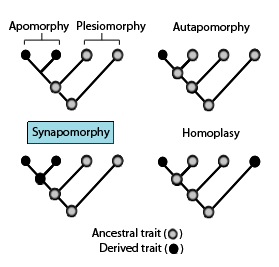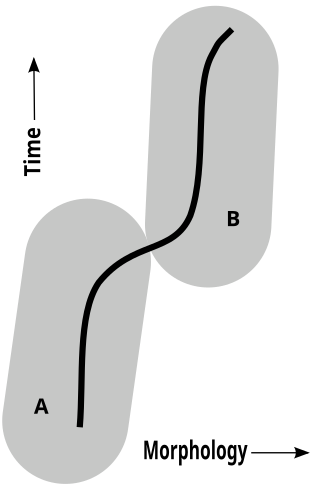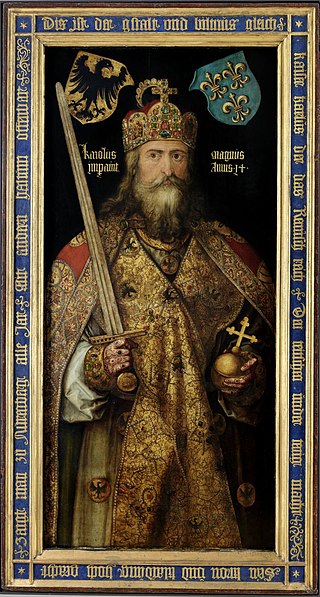Related Research Articles

A language family is a group of languages related through descent from a common ancestor, called the proto-language of that family. The term family is a metaphor borrowed from biology, with the tree model used in historical linguistics analogous to a family tree, or to phylogenetic trees of taxa used in evolutionary taxonomy. Linguists thus describe the daughter languages within a language family as being genetically related. The divergence of a proto-language into daughter languages typically occurs through geographical separation, with different regional dialects of the proto-language undergoing different language changes and thus becoming distinct languages over time.
In human genetics, the Mitochondrial Eve is the matrilineal most recent common ancestor (MRCA) of all living humans. In other words, she is defined as the most recent woman from whom all living humans descend in an unbroken line purely through their mothers and through the mothers of those mothers, back until all lines converge on one woman.
A phylogenetic tree, phylogeny or evolutionary tree is a graphical representation which shows the evolutionary history between a set of species or taxa during a specific time. In other words, it is a branching diagram or a tree showing the evolutionary relationships among various biological species or other entities based upon similarities and differences in their physical or genetic characteristics. In evolutionary biology, all life on Earth is theoretically part of a single phylogenetic tree, indicating common ancestry. Phylogenetics is the study of phylogenetic trees. The main challenge is to find a phylogenetic tree representing optimal evolutionary ancestry between a set of species or taxa. Computational phylogenetics focuses on the algorithms involved in finding optimal phylogenetic tree in the phylogenetic landscape.

In human genetics, the Y-chromosomal Adam, is the patrilineal most recent common ancestor (MRCA) from whom all currently living humans are descended. He is the most recent male from whom all living humans are descended through an unbroken line of their male ancestors. The term Y-MRCA reflects the fact that the Y chromosomes of all currently living human males are directly derived from the Y chromosome of this remote ancestor.
An ancestor, also known as a forefather, fore-elder, or a forebear, is a parent or (recursively) the parent of an antecedent. Ancestor is "any person from whom one is descended. In law, the person from whom an estate has been inherited."

A haplotype is a group of alleles in an organism that are inherited together from a single parent.

In phylogenetics, an apomorphy is a novel character or character state that has evolved from its ancestral form. A synapomorphy is an apomorphy shared by two or more taxa and is therefore hypothesized to have evolved in their most recent common ancestor. In cladistics, synapomorphy implies homology.
A most recent common ancestor (MRCA), also known as a last common ancestor (LCA), is the most recent individual from which all organisms of a set are descended. The term is also used in reference to the ancestry of groups of genes (haplotypes) rather than organisms.
Genetic genealogy is the use of genealogical DNA tests, i.e., DNA profiling and DNA testing, in combination with traditional genealogical methods, to infer genetic relationships between individuals. This application of genetics came to be used by family historians in the 21st century, as DNA tests became affordable. The tests have been promoted by amateur groups, such as surname study groups or regional genealogical groups, as well as research projects such as the Genographic Project.

Pseudoextinction of a species occurs when all members of the species are extinct, but members of a daughter species remain alive. The term pseudoextinction refers to the evolution of a species into a new form, with the resultant disappearance of the ancestral form. Pseudoextinction results in the relationship between ancestor and descendant still existing even though the ancestor species no longer exists.
In genetic genealogy, the identical ancestors point (IAP), also known as the all common ancestors (ACA) point, or genetic isopoint, is the most recent point in a given population's past such that each individual alive at that point either has no living descendants, or is the ancestor of every individual alive in the present. This point lies further in the past than the population's most recent common ancestor (MRCA).
Coalescent theory is a model of how alleles sampled from a population may have originated from a common ancestor. In the simplest case, coalescent theory assumes no recombination, no natural selection, and no gene flow or population structure, meaning that each variant is equally likely to have been passed from one generation to the next. The model looks backward in time, merging alleles into a single ancestral copy according to a random process in coalescence events. Under this model, the expected time between successive coalescence events increases almost exponentially back in time. Variance in the model comes from both the random passing of alleles from one generation to the next, and the random occurrence of mutations in these alleles.

A royal descent is a genealogical line of descent from a past or present monarch.
An adoption detective is an individual who researches biological and genetic connections between individuals. They conduct searches of public and private records, research historical documents, and interview persons of interest for the purpose of uncovering genealogical information linking biologically related individuals, persons related by marriage, foster parents, or other key contacts. Informally, a detective is any licensed or unlicensed person who solves crimes, including historical crimes, or looks into records. Also known as private investigators, police detectives must pass written tests after completion of the requirements for being a police officer.
Incomplete lineage sorting (ILS) (also referred to as hemiplasy, deep coalescence, retention of ancestral polymorphism, or trans-species polymorphism) is a phenomenon in evolutionary biology and population genetics that results in discordance between species and gene trees. By contrast, complete lineage sorting results in concordant species and gene trees. ILS occurs in the context of a gene in an ancestral species which exists in multiple alleles. If a speciation event occurs in this situation, either complete lineage sorting will occur, and both daughter species will inherit all alleles of the gene in question, or incomplete lineage sorting will occur, when one or both daughter species inherits a subset of alleles present in the parental species. For example, if two alleles of a gene are present and a speciation event occurs, one of the two daughter species might inherit both alleles, but the second daughter species only inherits one of the two alleles. In this case, incomplete lineage sorting has occurred.
Viral phylodynamics is the study of how epidemiological, immunological, and evolutionary processes act and potentially interact to shape viral phylogenies. Since the term was coined in 2004, research on viral phylodynamics has focused on transmission dynamics in an effort to shed light on how these dynamics impact viral genetic variation. Transmission dynamics can be considered at the level of cells within an infected host, individual hosts within a population, or entire populations of hosts.

The International Society of Genetic Genealogy (ISOGG) is an independent non-commercial nonprofit organization of genetic genealogists run by volunteers. It was founded by a group of surname DNA project administrators in 2005 to promote DNA testing for genealogy. It advocates the use of genetics in genealogical research, provides educational resources for genealogists interested in DNA testing, and facilitates networking among genetic genealogists. As of June 2013, it comprises over 8,000 members in 70 countries. As of July 2013, regional meetings are coordinated by 20 volunteer regional coordinators located in the United States, Australia, Brazil, Canada, England, Egypt, Ireland and Russia.

The following outline is provided as an overview of and topical guide to evolution:
This glossary of genetics and evolutionary biology is a list of definitions of terms and concepts used in the study of genetics and evolutionary biology, as well as sub-disciplines and related fields, with an emphasis on classical genetics, quantitative genetics, population biology, phylogenetics, speciation, and systematics. It has been designed as a companion to Glossary of cellular and molecular biology, which contains many overlapping and related terms; other related glossaries include Glossary of biology and Glossary of ecology.
In the field of epidemiology, source attribution refers to a category of methods with the objective of reconstructing the transmission of an infectious disease from a specific source, such as a population, individual, or location. For example, source attribution methods may be used to trace the origin of a new pathogen that recently crossed from another host species into humans, or from one geographic region to another. It may be used to determine the common source of an outbreak of a foodborne infectious disease, such as a contaminated water supply. Finally, source attribution may be used to estimate the probability that an infection was transmitted from one specific individual to another, i.e., "who infected whom".
References
- ↑ Harding, Rosalind, M. (1998), "New phylogenies: an introductory look at the coalescent.", in Nee, S (ed.), New uses for new phylogenies, Oxford University Press, ISBN 0-19-854984-9
{{citation}}: CS1 maint: multiple names: authors list (link) - ↑ Land, Judith and Martin (2011), "Chapter 15 - Gateway to Adulthood (p. 121)", Adoption Detective: Memoir of an Adopted Child, Wheatmark, ISBN 978-1-60494-571-3